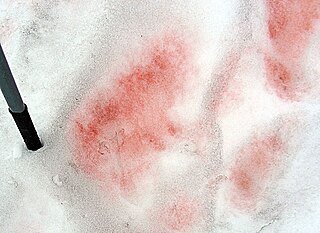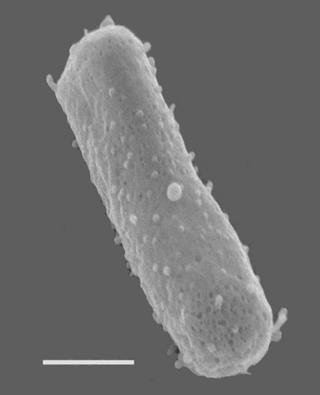Related Research Articles
The halophiles, named after the Greek word for "salt-loving", are extremophiles that thrive in high salt concentrations. While most halophiles are classified into the domain Archaea, there are also bacterial halophiles and some eukaryotic species, such as the alga Dunaliella salina and fungus Wallemia ichthyophaga. Some well-known species give off a red color from carotenoid compounds, notably bacteriorhodopsin. Halophiles can be found in water bodies with salt concentration more than five times greater than that of the ocean, such as the Great Salt Lake in Utah, Owens Lake in California, the Urmia Lake in Iran, the Dead Sea, and in evaporation ponds. They are theorized to be a possible analogues for modeling extremophiles that might live in the salty subsurface water ocean of Jupiter's Europa and similar moons.

Snow algae are a group of freshwater micro-algae which grow in the alpine and polar regions of the earth. These algae have been observed to come in a variety of colors associated with both the individual species, stage of life or topography/geography. This variation is associated with both albedo differences of the snowy habitat and the presence of micro-invertebrates. Snow algae play a critical role in the trophic organization as primary producers who in turn are consumed primarily by tardigrades and rotifers. Snow algae have also been found to travel great distances being carried by winds.

Haloarchaea are a class of the Euryarchaeota, found in water saturated or nearly saturated with salt. Halobacteria are now recognized as archaea rather than bacteria and are one of the largest groups. The name 'halobacteria' was assigned to this group of organisms before the existence of the domain Archaea was realized, and while valid according to taxonomic rules, should be updated. Halophilic archaea are generally referred to as haloarchaea to distinguish them from halophilic bacteria.

Halobacterium salinarum, formerly known as Halobacterium cutirubrum or Halobacterium halobium, is an extremely halophilic marine obligate aerobic archaeon. Despite its name, this is not a bacterium, but a member of the domain Archaea. It is found in salted fish, hides, hypersaline lakes, and salterns. As these salterns reach the minimum salinity limits for extreme halophiles, their waters become purple or reddish color due to the high densities of halophilic Archaea. H. salinarum has also been found in high-salt food such as salt pork, marine fish, and sausages. The ability of H. salinarum to survive at such high salt concentrations has led to its classification as an extremophile.
Chromohalobacter beijerinckii is a motile, rod-like, salt-loving, Gram-negative soil bacterium, 0.4–0.6 μm by 1.8–2.5 μm.
Natrinema versiforme is an extremely halophilic archaeon. It is neutrophilic, non-motile and pleomorphic, with type strain XF10T.
Halococcus salifodinae is an extremely halophilic archaeon, first isolated in an Austrian salt mine. It is a coccoid cell with pink pigmentation, its type strain being Blp.
Colwellia demingiae is a psychrophilic Antarctic bacterial species with the ability to synthesize docosahexaenoic acid. It is nonpigmented, curved-rod-like in shape, exhibiting facultative anaerobic growth, and possessing an absolute requirement for sea water. Its type strain is ACAM 459T. This bacteria is named after Jody Deming, a professor and researcher at University of Washington and her research mentor, Rita Colwell.
Colwellia hornerae is a psychrophilic Antarctic bacterial species with the ability to synthesize docosahexaenoic acid. It is nonpigmented, curved-rod-like in shape, exhibiting facultative anaerobic growth and possessing an absolute requirement for sea water. Its type strain is ACAM 607T.
Colwellia rossensis is a psychrophilic Antarctic bacterial species with the ability to synthesize docosahexaenoic acid. It is non-pigmented, curved rod-like shaped, exhibiting facultative anaerobic growth and possessing an absolute requirement for sea water. Its type strain is ACAM 608T.
Colwellia psychrotropica is a psychrophilic Antarctic bacterial species with the ability to synthesize docosahexaenoic acid. It is nonpigmented, curved-rod-like in shape, exhibiting facultative anaerobic growth and possessing an absolute requirement for sea water. Its type strain is ACAM 179T.
Halobacterium noricense is a halophilic, rod-shaped microorganism that thrives in environments with salt levels near saturation. Despite the implication of the name, Halobacterium is actually a genus of archaea, not bacteria. H. noricense can be isolated from environments with high salinity such as the Dead Sea and the Great Salt Lake in Utah. Members of the Halobacterium genus are excellent model organisms for DNA replication and transcription due to the stability of their proteins and polymerases when exposed to high temperatures. To be classified in the genus Halobacterium, a microorganism must exhibit a membrane composition consisting of ether-linked phosphoglycerides and glycolipids.
Halobiforma haloterrestris is an extremely halophilic member of the Halobacteria and the type species of the genus Halobiforma. H. haloterrestris is aerobic and motile. The cells are red-pigmented, neutrophilic and show rod, coccus and slightly pleomorphic morphology.
Lentibacillus juripiscarius is an aerobic, spore-forming, Gram-positive, moderately halophilic bacteria, with type strain IS40-3T.
Methylocystis rosea is a methanotrophic, Gram-negative, rod-shaped, non-spore-forming and non-motile bacterium species from the genus of Methylocystis which has been isolated from arctic wetland soil on the Svalbard Islands in Norway.
Nocardiopsis alkaliphila is an alkaliphilic bacterium from the genus of Nocardiopsis which has been isolated from soil from Egypt. Nocardiopsis alkaliphila produces nocardiopyrone A, nocardiopyrone B and pyridinols.
Nocardiopsis salina is a halophilic bacterium from the genus of Nocardiopsis which has been isolated from hypersaline soil in the Xinjiang Province in China.
Hymenobacter is a Gram-negative and non-motile bacterial genus from the family Hymenobacteraceae.
Haloterrigena turkmenica is an aerobic chemo organotrophic archeon originally found in Turkish salt lakes.
Pontibacter korlensis is a Gram-negative and rod-shaped bacterium from the genus of Pontibacter which has been isolated from the desert of Xinjiang in China.
References
- ↑ Stan-Lotter, H. (2002). "Halococcus dombrowskii sp. nov., an archaeal isolate from a Permian alpine salt deposit". International Journal of Systematic and Evolutionary Microbiology. 52 (5): 1807–1814. doi:10.1099/ijs.0.02278-0. ISSN 1466-5026.